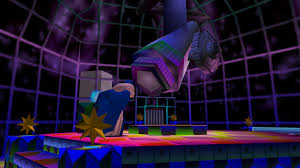
Video games frequently employ visual representations of the player in the form of an avatar. For a large amount of those games, the avatar is not only an icon, but a "real thing" that exists on a level continuous with the world forged out by the game's sense of physical reality. The avatar can be manipulated, we empathize with it and project our bodies into it, viewing blocks and obstacles as genuine physical problems, things to be overcome in the same way that we must navigate around and between cars in traffic. This is the core design philosophy of one of the most historically significant genres of video games, the platformer - one which found its full expression and potential for empathetic embodiment (i.e. a well-connected "analogization" whereby I analogize myself to the avatar) in the 3D revolution ushered in by Super Mario 64 (1996). While we can view physical things as barriers, we may also view them as assembling a 'space,' a place where things happen, an environment or a context in which we exist. The "room," the "space," the "area," the "level" is inhabited, dwelled in, lived in. To live in these kinds of spaces is not just a matter of functionality, not just taking the necessary acts to proceed in advancing toward the game's set of goals, but crucially an aesthetic experience. I find myself in Princess Peach's Castle. I walk through the doors to get to the levels, but I notice the color palette, the music, Mario's sounds and how they differ as I tap against the tile floor. The stained glass, carpet, flourishes of royal reds. The space breathes, like a place where things can and do happen.
In this little blog post, I will be discussing a few of my favorite video game "spaces." I'll explain why they're my favorites, what cool design elements they have, what feelings they are meant to evoke, what makes them fun to simply inhabit.
Starting off, we have the Astral Observatory in The Legend of Zelda: Majora's Mask (2000).

The Astral Observatory is a location that is beloved by many who play Majora's Mask. Perhaps it is because it feels like a safe haven from the ugly and scary world of Termina. That is at least partially true for many, I assume. But the most striking aspect of it to me has always been the walls. The moving textures of the dark clouds and stars against the black background and purple tiling are mesmerizing. There's a sense of motion that inhabits the location. It is a steady motion that gives one a sense of being in celestial harmony, gracing through the cosmos. The purple and yellow and green colors are unusual but comforting. The presence of Professor Shikashi, an elderly man, acts as a steady hand and companion in the vast mystery of space. He stays by your side, someone who guides you with his knowledge and wisdom. The killer feature of this room, the piece that brings it together, is the music. The "Astral Observatory" track is intensely memorable, resonating, repetitive, twinkling, like the orderly dance of planets, for an eternity. Emotions repeat, begin and end anew, and coalesce to create something grand and beautiful.